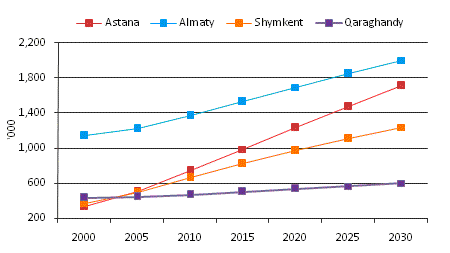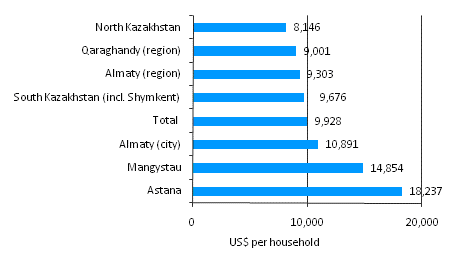Kazakhstan’s urbanisation trends shape business opportunities
Kazakhstan is becoming increasingly urbanised, with the urban population projected to reach 66.3% of the total by 2030, from 57.7% in 2009. Kazakhstanis migrate from villages and smaller towns to the largest cities in search of higher incomes, better employment prospects and modern lifestyles. The government has expressed commitment to managing internal migration while urbanisation will provide many business opportunities.• The population of the capital Astana grew by 49.1% between 2004 and 2009, reaching 690,000. It is expected to reach 1.7 million by 2030. However, Almaty, the capital city until 1998, remains the country's most populous city, at 1.3 million in 2009.
• Shymkent, Kazakhstan's third-largest city and an important oil refining and industry centre grew by 35.6% in 2004-2009. Qaraghandy, the country's fourth largest city thrived during Soviet times as a coal mining centre but has lost much of its economic importance and the population grew by only 5.4% in 2004-2009.
Chart 1: Kazakhstan’s urban population in selected cities: 2000-2030
'000

Source: Euromonitor International from national statistics/UN
• The share of the rural population remains significant at 42.3% of the total in 2009. However, agriculture is declining in importance and accounted for 5.1% of GDP in 2009 compared to 7.4% in 2004.
Implications
• Kazakhstan's rural areas are sparsely populated, with the country's population density of 5.8 people per square km in 2009 one of the lowest in the world. The cost of developing transport and infrastructure across vast unpopulated areas has restricted government investment in rural areas, while Kazakhstan's cities modernised amid rapid economic growth.
• The official unemployment rate of 6.5% in 2009 is believed to underestimate unemployment and underemployment. With the qualified workforce migrating to the main cities, investors find it difficult to attract workers elsewhere.
• In 2004-2009, the government invested a significant share of its largely oil-dependent revenues in urban development projects. The construction boom created numerous opportunities for foreign companies, but was largely brought to a halt by the international economic crisis.
• Kazakhstan's economic growth averaged 8.6% annually in real terms in 2003-2008, but slowed to 1.2% in 2009 as a result of low international oil prices, a sharp decline in remittances and lower credit availability. A modest recovery to 2.4% real growth is expected in 2010.
• The gap between consumer lifestyles in rural and urban regions is increasing, with most opportunities concentrated in Kazakhstan's three largest cities. In 2009, consumer expenditure was US$18,237 per household in the capital city of Astana, the highest in the country.
Chart 2: Annual consumer expenditure per household in selected regions in Kazkastan: 2009
US$ per household

Source: Euromonitor International from national statistics/OECD/Eurostat
• As the dominant oil sector has low labour intensity, most rural Kazakhstanis have few options but to be employed in agriculture but the sector has been declining in importance. In 2009, exports of mineral fuels represented 68.7% of exports. In March 2010, the European Bank for Reconstruction and Development committed to investing up to US$1.0 billion to help the Kazakhstani government diversify the economy. With government aspirations to making Kazakhstan a high-tech hub, this is unlikely to be directed towards the agricultural sector.
• Urbanisation is shaping consumer demand, with city-based households generally smaller and more interested in imported or luxury goods but it could also put pressure on urban infrastructure.
Prospects
• The urban population will reach 12.8 million by 2030. Astana will remain the fastest-growing city, reaching 1.7 million by 2030 but Almaty will remain the most populous city, reaching 2.0 million in the same year.
• The economic crisis has caused the government to seek the most affordable measures for controlling rural-urban migration, such as re-introducing Soviet-era residency registration in Almaty and Astana. Residency in the major cities may be restricted in an effort to reduce migration levels.
• With disposable incomes in cities rapidly growing, opportunities are arising for marketers to offer goods and services to consumers aspiring to Western lifestyles.
Source: www.euromonitor.com
